Siuntio
Siuntio (Finnish pronunciation: [ˈsiuntio]; Swedish: Sjundeå) is a municipality of Finland.
Siuntio Siuntio – Sjundeå | |
|---|---|
Municipality | |
| Siuntion kunta Sjundeå kommun | |
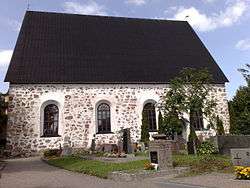 St. Peter's Church in Siuntio | |
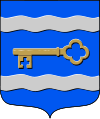 Coat of arms | |
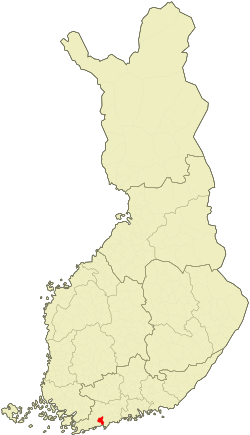 Location of Siuntio in Finland | |
| Coordinates: 60°08′N 024°13′E | |
| Country | |
| Region | Uusimaa |
| Sub-region | Helsinki sub-region |
| Government | |
| • Municipality manager | Juha-Pekka Isotupa |
| Area (2018-01-01)[1] | |
| • Total | 266.12 km2 (102.75 sq mi) |
| • Land | 241.16 km2 (93.11 sq mi) |
| • Water | 24.96 km2 (9.64 sq mi) |
| Area rank | 249th largest in Finland |
| Population (2019-01-31)[2] | |
| • Total | 6,142 |
| • Rank | 154th largest in Finland |
| • Density | 25.47/km2 (66.0/sq mi) |
| Population by native language | |
| • Finnish | 65.8% (official) |
| • Swedish | 31.7% |
| • Others | 2.4% |
| Population by age | |
| • 0 to 14 | 22.3% |
| • 15 to 64 | 66.5% |
| • 65 or older | 11.2% |
| Time zone | UTC+02:00 (EET) |
| • Summer (DST) | UTC+03:00 (EEST) |
| Municipal tax rate[5] | 21% |
| Unemployment rate | 5.8% |
| Climate | Dfb |
| Website | www.siuntio.fi |
It is located in the province of Southern Finland and is part of the Uusimaa region. The municipality has a population of 6,142 (31 January 2019)[2] and covers an area of 266.12 square kilometres (102.75 sq mi) of which 24.96 km2 (9.64 sq mi) is water.[1] The population density is 25.47 inhabitants per square kilometre (66.0/sq mi).
The municipality is bilingual with the majority being Finnish and the minority Swedish-speakers. Siuntio had the majority of population speaking Swedish until 1980s. The oldest document mentioning Siuntio dates back to the year 1382.[6] The Finnish speaking parish of Siuntio belongs to Espoo diocese and the Swedish speaking parish of Siuntio to Porvoo diocese.[7]
Municipalities neighbouring Siuntio are Ingå, Kirkkonummi, Lohja and Vihti.
History
Early history
Siuntio has been inhabited already since the Stone Age. The river valley around the medieval Siuntio church is where the oldest marks of farming have been discovered. A Bronze-Age burial site can also be found near the church, on top of the Krejansberget hill. The oldest document mentioning Siuntio is from the year 1382 and it addresses a donation for the Church of St. Lawrence in Lohja.[8]
The Middle Ages
During the Middle Ages Siuntio became an important area as two large manor houses, Suitia and Sjundby, were built there.[9] The earliest mention of Suitia Manor House is from 1420 in a document addressing a border conflict between Suitia estate and an estate owned by the bailiff of Häme Castle. Later on the estate came to the possession of the powerful and influential Fleming family. The Flemings gained a lot of new land for Suitia estate and at one point Suitia had even its own harbor by the sea near the mouth of Pickala river.[10] Flemings also built the first iron works, located on Suitia Manor House's land, in Finland in 1530s.[11] The Sjundby Manor House on the other hand is first named on a document from 1417. The stone-castle-like building was owned by many influential noble families but the most famous of the owners must be the Queen Christina of Sweden.[12]
The medieval King's Road from Turku to Vyborg, used by the kings of Sweden, merchants and pilgrims, runs through Siuntio.
The medieval St. Peter's Church was built around 1480. The church had smaller churches standing on the same place before the construction of church we see nowadays but they were most likely built out of wood and couldn't stand the test of time. The church has biblical paintings on the vaults which also date to the Middle Ages. The sacristy, which was also the oldest part of the church, and "armory" were removed after the church caught fire in 1823.[13]
1800–2000
The National Author of Finland, Aleksis Kivi, lived in Siuntio in Fanjunkars croft from 1864 to 1871.[14]
The old municipality centre around the church started to lose its importance after the construction of the coastal railway. The new railway station was built a few kilometres south from the church which resulted in the creation of the new municipal centre around the railway station.[15]
After the Second World War parts of Southern Siuntio were leased to Soviet Union together with the rest of the Porkkala Naval Base for 50 years following the 1944 Moscow Armistice concluded between Finland, Soviet Union and the United Kingdom.[16] Although the lease time didn't last 50 years, signs of Soviet occupation can still be found around the area. The most famous reminders of the lease are military orders written in Cyrillic script on the walls of the dairy house of the Sjundby Manor House, and a Soviet Triumphal Arch near Pickala Manor House.[17]
2000–present
In 2011 Siuntio, together with municipalities of Karjalohja, Sammatti and Nummi-Pusula, decided to merge to the city of Lohja starting in 2013. The decision was made following the encouragement from the Finnish State to merge smaller municipalities together to create larger administrative areas to eventually cut costs. However the decision caused a conflict between the Siuntio political parties also dividing the population, and after several unclear negotiation Siuntio failed to deliver any kinds of answers and therefore was cut out of the merge with Lohja.[18][19]
In 2018 Siuntio joined the Helsinki Regional Transport securing good public transportation connections to Helsinki sub-region.[20]
Politics
Results of the 2011 Finnish parliamentary election in Siuntio:
- National Coalition Party 25.0%
- Swedish People's Party 21.5%
- Social Democratic Party 16.6%
- Finns Party 16.2%
- Green League 10.2%
- Centre Party 4.3%
- Left Alliance 3.5%
- Christian Democrats 1.7%
Nature and geography
Siuntio is located on the south coast of Finland west from the capital Helsinki. It is neighboured by Ingå in west, Kirkkonummi in east, Lohja in north-west and Vihti in north.
The hilly landscape of Siuntio with its valleys are characteristic for this municipality. The northern part of Siuntio has many high hills and a large esker covered in forest while the southern part of Siuntio is less hilly but also covered in forests. Smaller and larger lakes can also be found on the southern and middle parts of Siuntio. The west parts of Siuntio have large flat areas of cultivated fields.[13]
Siuntio has also a few Natura 2000 nature protection areas such as the Plytberg Oak Forest, Torsgård's old forest, Meiko-Lappträsk lake area and the riverbanks of Siuntio river.[18]
Lakes in Siuntio
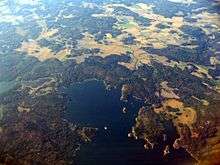
The 15 lakes and large ponds in Siuntio are Tjusträsk, Vikträsk, Lappträsk, Fåträsk, Svartträsk, Kakarträsk, Ormträsk, Grundträsk, Hakuträsk, Byträsk, Vikträsk, Storträsk, Lillträsk, Karhujärvi and Kvarnträsk. The largest lake is Lake Karhujärvi.[7]
The Siuntio river
The Siuntio river is the most dominant part of the nature in this area. Most parts of the municipality's borders follow the river and its tributaries. The Siuntio river starts from Lake Hiidenvesi in Vihti and after about 20 km ends in Baltic Sea. After the Ice Age the area of Siuntio was almost completely submerged with only highest hills visible on top of the sea. At that time the Siuntio river was a large sound bordered by the Lohja esker. Due to the post-glacial rebound more and more land was rising from the sea and the shoreline moved further and further away. The only water elements still visible nowadays from that era are the Siuntio river and a few lakes such as Lake Tjusträsk and Lake Karhujärvi.
The "Alps of Siuntio" and the "Amazon of Siuntio"
The high hills near Siuntio church all the way to the Lake Karhujärvi are sometimes described as the Alps of Siuntio or the Switzerland of Siuntio due to the high terrain and wild untouched nature.
The last kilometre of the Siuntio River, also known as the Pickala River, is described as the Amazon of Siuntio because of its extraordinarily beautiful nature and the grand black alders growing on the riverbanks.
Villages and hamlets
Aiskos, Andby, Backa, Bläsaby, Bocks, Bollstad, Broända (with Hovgård), Bäcks, Böle, Dansbacka, Engisby, Fall, Fjällskifte, Flyt, Fågekvik, Förby, Gammelby, Grisans, Grotbacka, Grännäs, Grönskog, Gårdskulla, Gårsböle, Gösarv, Gårdsböle, Gästans, Göks, Harvs, Hollstens, Hummerkila, Hästböle, Järvans, Kalans, Kanala, Karskog, Karuby, Kehla or Käla, Kockis, Kopula, Kvarnby, Kynnar, Lempans, Malm, Munks, Myrans, Mörsbacka, Nordanvik, Nummenkylä, Nyby, Niemenkylä, Palmgård, Pappila, Paturs, Pickala, Pulkbacka, Purnus, Påvals or Påvalsmalm, Pölans, Siggans, Sjundby, Skinnars, Skräddarskog, Störsby, Störsvik, Sunnanvik, Svartbäck, Suitia, Tyyskylä (Tjusterby), Tupala, Tupala Nyby, Veijola (Veijans or Vejans), Vesterby, Vikars, Ängsholm, Yövilä (Övitsby)[21]
Urban area
In 2019 there were 6 126 inhabitants in Siuntio and about half of them were living in the urban areas of Siuntio. The largest urban areas of Siuntio are the new municipal centre Siuntio Station Area around the railway station and the old municipal centre Siuntio Church Village around Siuntio church. About 2 500 people were living around the Siuntio railway station and, much less, about 350 people were living around the St. Peter's Church.[19]
Sports
Sjundeå Idrottsförening, shortly Sjundeå IF or SIF, is a sports club established in 1918 in Siuntio. The main sports they play are handball and athletics. Both men's and women's handball teams are one of the best ones in Finland. The largest handball cup of Finland, Sjundeå Cup, is annually played in Siuntio.[10]
Pickala Golf, located in Siuntio, is the largest golf club in Finland and the Nordic Countries with its 54 holes. The golf club has three completely different courses of 18 holes.[22]
Religion
Christianity is the major religion in Siuntio. Evangelical Lutheran Church of Finland is the largest religious organisation in Siuntio and it is divided into two parishes; Siuntio Finnish-speaking parish and Siuntio Swedish-speaking parish. Both parishes share the medieval stone church dedicated for St. Peter.[9]
The Finnish Orthodox Church of Helsinki has also activity in Siuntio.[23]
Sights and cultural heritage
The Medieval Church of St. Peter
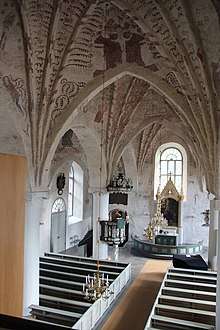
The Church of St. Peter in Siuntio was built around 1480s during Finland's Catholic time and church still has biblical paintings on its vaults from that era. The oldest objects inside the church are also from the Middle Ages.
Suitia Manor House
Suitia Manor House (Fin. Suitian kartano, Swe. Svidja slott) is a large stone-built Manor House built around 1540s. The walls of this grand two-storey building were made over one meter thick for defensive reasons. The first floor was rebuilt in the beginning of 1760s by Esbjörn Reuterholm. The gothic appearance we can see nowadays was added to the Manor House by August Wrede in the late 19th century and early 20th century. Suitia's large garden includes a small family cemetery of the owners of Suitia.
The state of Finland sold Suitia to a private owner with 11.7 million euros in 2015. Suitia, together with St. Peter's Church are listed as Nationally Significant Built Cultural Environment and are protected by the Finnish Heritage Agency.[24]
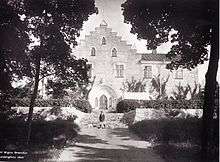
Sjundby Manor House
Sjundby Manor House was built in 1560s by Swedish king Gustav Vasa's stall master Jakob Henriksson. The Manor House resembles a large stone-built castle by River Sjundby. The estate has been owned by many important noble families as well as royalty. Princess Sigrid Vasa of Sweden and Queen Christina of Sweden were perhaps the two most famous owners of Sjundby. Adlercreutz family has owned Sjundby since the 18th century and tours inside the castle are arranged during summer.

During the Soviet lease of Porkkala Naval Base Sjundby was also on the Soviet side of the border. Sjundby was badly damaged during this time but fortunately restored. Writings in Cyrillic script, telling about how Soviet soldiers should behave, can still be seen on the walls of Sjundby dairy house. Sjundby is also listed as Nationally Significant Built Cultural Environment and protected by the Finnish Heritage Agency.[25]
Pickala Manor House and Soviet Triumphal Arch
Pickala Manor House is known since the 16th century but the main building standing today is much newer and dates to 1850. The manor house's garden also dates to the 19th century and, in fact, hasn't been changed since. Pickala Manor House was also on the Soviet side of the border during the leasing time and acted as part of the Soviet cadre.
Near the manor house a gobble stone road, known as the Kabanov's road, runs from Pickala to a Soviet Triumphal Arch which is the only surviving Soviet triumphal arch in Finland. The road was paved with gobble stone to make it strong enough for Soviet military vehicles to drive on.[26]
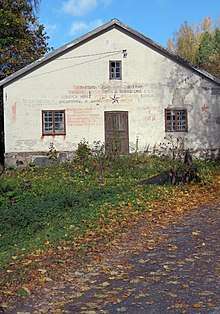
Pickala area is listed as Nationally Significant Built Cultural Environment and protected by the Finnish Heritage Agency.[27]
Kela Railway Station
Kela railway station was built in 1903 and its style is an excellent example of the type 5 small wooden railway station. The station is private property but protected by the Finnish Heritage Agency and listed as Nationally Significant Built Cultural Environment.[28]
Fanjunkars
The national author of Finland, Aleksis Kivi, lived in Fanjunkars croft in Siuntio together with Charlotta Lönnqvist in 1864–1871. Fanjunkars was the place where Kivi wrote one of his most famous novel The Seven Brothers and many poems and plays. Fanjunkars was left on the Soviet side of the border and completely destroyed by Soviets regardless of people pleading for the well treatment of the building. A reconstruction of Fanjunkars was built to Siuntio municipal centre in 2002. The new Fanjunkars acts as a museum and an event location.[29]
Bronze Age burial sites
There are many Bronze Age burial sites in Siuntio but most famous ones are located on top of the Krejansberget hill near Siuntio church and local history museum.[30]
Siuntio Local History Museum
The local history museum of Siuntio presents local artefacts from the Stone Age all the way to the modern Siuntio. The museum works in the former Fredriksberg's school building. Museum is open during summer.[30]
Siuntio Spa and Lepopirtti
Siuntio Spa was built near Lepopirtti, a wellness centre for working-class women, in 1976. Siuntio spa offers wellness services and has 3 pools, sports fields and nature paths. The spa is located by Lake Tjusträsk.[31]
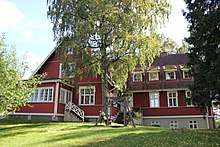
Lepopirtti wooden villa was built in 1917 and worked as a wellness centre for working-class women who were in desperate need of rest. Lepopirtti was opened by Finland's first female minister Miina Sillanpää in 1921.[31]
Tjusterby Manor House
Tjusterby Manor House was one of the oldest wooden manor houses in Siuntio. The house was located near the church in the Tjusterby hamlet. The Manor House was moved from Helsinki to Siuntio in the late 19th century. Tjusterby Manor was destroyed in a large fire in 2011 causing Siuntio to lose a piece of its cultural history.[32]
A new Tjusterby manor was built on the same spot but this time built out of stone.
Gårdskulla Manor and Agricultural Museum
Gårdskulla manor is one of the largest farms in Finland with about 680ha of land. The main building is from 1850s. Gårdskulla has a large collection of agricultural artefacts shown in its private museum. Over 100 old tractors, some cars, tools and steam machines are shown there.[33]
Canoeing by Siuntio river and Siuntio archipelago
Canoeing by Siuntio river and at Siuntio archipelago is a popular activity and tours with different destinations, such as Sjundby Manor, are organised in Siuntio.[34]
Education
After the decision to close and sell Päivärinne primary school there have been two schools in Siuntio; Aleksis Kivien Koulu and Sjundeå Svenska Skolan schools. Aleksis Kiven Koulu has a primary school and upper comprehensive school and offers education in Finnish. Sjundeå Svenska Skolan only has primary school and offers education in Swedish.
In the 20th century Siuntio had a fairly large amount of small village schools but the municipality has ended up focusing the schools in the municipal centre.
Siuntio doesn't have any upper secondary schools and teenagers usually start going to school in Kirkkonummi, Lohja, Vihti or Helsinki after upper comprehensive school.[35]
Transportation
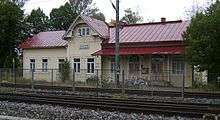
After the Finnish state's train company threatened to cut Siuntio out of active train station stops Siuntio decided to join Helsinki Regional Transportation in 2018. The coastal railway between Helsinki and Turku is important for Siuntio as it secures fast movement to Helsinki metropolitan area.
Coat of arms
The coat of arms of Siuntio pictures St. Peter's (the patron saint of Siuntio St. Peter's church) key in the middle and below and on top of the key are waves that represent the Siuntio River. The colours of the coat of arms, blue, silver and gold, stem from the coat of arms of Uusimaa region.
References
- "Area of Finnish Municipalities 1.1.2018" (PDF). National Land Survey of Finland. Retrieved 30 January 2018.
- "Suomen virallinen tilasto (SVT): Väestön ennakkotilasto [verkkojulkaisu]. Tammikuu 2019" (in Finnish). Statistics Finland. Retrieved 15 March 2019.
- "Population according to language and the number of foreigners and land area km2 by area as of 31 December 2008". Statistics Finland's PX-Web databases. Statistics Finland. Retrieved 29 March 2009.
- "Population according to age and gender by area as of 31 December 2008". Statistics Finland's PX-Web databases. Statistics Finland. Retrieved 28 April 2009.
- "List of municipal and parish tax rates in 2011". Tax Administration of Finland. 29 November 2010. Retrieved 13 March 2011.
- Favorin, Martin (1986). Siuntion Historia. Ekenäs: Siuntion kunta. p. 41.
- "Information, kansli - Sjundeå svenska församling". www.sjundeaforsamling.fi. Retrieved 2019-10-18.
- Favorin, Martti (1986). Siuntion Historia. Ekenäs: Siuntion kunta.
- "RKY ι Museiverket". www.kulturmiljo.fi. Retrieved 2019-10-18.
- "Svidja < Uppslagsverket < TWiki". archive.is. 2016-02-16. Archived from the original on 2016-02-16. Retrieved 2019-10-18.
- Uotila, Anne (15 October 2008). "Siuntiosta löytyi Suomen vanhin rautaruukki". Länsi-Uusimaa.
- Brenner, Alf (1964). Sjundeå sockens historia. Sjundeå: Hembygdens vänner i Sjundeå.
- "Sjundeå kyrka". Sjundeå svenska församling (in Swedish). Retrieved 2019-10-18.
- "Fanjunkars - Aleksis Kivi". www.fanjunkars.fi. Retrieved 2019-10-18.
- Favorin, Martin (1986). Siuntion historia. Ekenäs: Siuntion kunta.
- "Armistice Agreement". heninen.net. Retrieved 2019-10-18.
- "Start - Sjundby". www.sjundby.fi. Retrieved 2019-10-18.
- "Sjundeå sade ja till kommunfusionen med Lojo". Hbl.fi | Finlands ledande nyhetssajt på svenska. Retrieved 2019-10-18.
- Uotila, Anne. "Uusi Lohja syntyy ilman Siuntiota". Länsi-Uusimaa (in Finnish). Retrieved 2019-10-18.
- "Tervetuloa mukaan, Siuntio!". HSL (in Finnish). Retrieved 2019-10-18.
- "Svenska ortnamn i Finland - Institutet för de inhemska språken". kaino.kotus.fi. Retrieved 2019-10-18.
- "Etusivu". Pickala Golf (in Finnish). Retrieved 2019-10-19.
- "Helsingin ortodoksinen seurakunta". Suomen ortodoksinen kirkko (in Finnish). Retrieved 2019-10-18.
- "RKY ι Museovirasto". www.rky.fi. Retrieved 2019-10-19.
- "RKY ι Museovirasto". www.rky.fi. Retrieved 2019-10-19.
- "RKY ι Museovirasto". www.rky.fi. Retrieved 2019-10-19.
- "RKY ι Museovirasto". www.rky.fi. Retrieved 2019-10-19.
- "RKY ι Museovirasto". www.rky.fi. Retrieved 2019-10-19.
- "Fanjunkars - Fanjunkarsin historia". fanjunkars.web27.neutech.fi. Retrieved 2019-10-19.
- "Siuntion kotiseutumuseo | Länsi-Uudenmaan museoportaali". Retrieved 2019-10-19.
- "Säätiö". Miina Sillanpään Säätiö (in Finnish). Retrieved 2019-10-19.
- "Tyyskylän vanha kartano paloi Siuntiossa". Yle Uutiset (in Finnish). Retrieved 2019-10-19.
- "Evenemang". www.gardskulla.fi. Retrieved 2019-10-19.
- "Siuntionjoki ja saaristo - SE-Action". www.seaction.com (in Finnish). Retrieved 2019-10-19.
- "Perusopetus". www.siuntio.fi. Retrieved 2019-10-19.
External links


- Municipality of Siuntio – Official website (in Finnish and Swedish)
